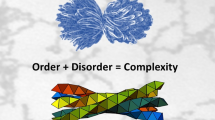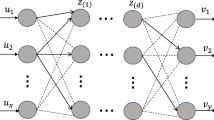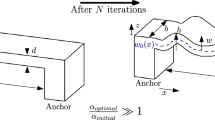Abstract
We develop a deep learning architecture for inverse design of a self-oscillating sheet propelled by an embedded chemical reaction. The dynamics of our problems are nonlinear and exhibit chaotic behavior, a challenging setting for existing deep-learning-based inverse design approaches. The aim is to explore data-driven design of soft robots using a novel locomotion mechanism. We train the architecture using a forward model of the locomotion mechanism developed recently by Alben et al. (J Comput Phys 399:108952, 2019). The architecture is shown to successfully map a snapshot of target motions of the gel into geometric and reaction parameters. The final architecture consists of a multi-layer perceptron (MLP) classifier for discrete parameters, followed by a stacked MLP regressor (SMLPR) for continuous parameters. Our inverse design setting is unique in that it considers both discrete and continuous outputs, requiring an architecture capable of classification and regression. We are able to recover parameters within 2.87% accuracy. We also compare the simulated motion of the sheets at the recovered parameters. Because the motion has a chaotic quality, our demonstration is able to show quantitative agreement for a small time horizon and qualitative agreement over longer time horizons. We also demonstrate agreement of Lyapunov exponents up to 6.78% accuracy for suitable motions.



















Similar content being viewed by others
Data availability
All the trained networks in this paper along with the python and MATLAB scripts responsible for creating them can be found in the Bitbucket repository bitbucket.org/dorukaks/workspace/projects/CGL.
Notes
February 20, 2020.
The files are named as set[setnumber]_[actual/predicted] _[300/20]s.gif.
Alan Wolf (2021). Wolf Lyapunov exponent estimation from a time series. (https://www.mathworks.com/matlabcentral/fileexchange/48084-wolf-lyapunov-exponent-estimation-from-a-time-series), MATLAB Central File Exchange. Retrieved December 22, 2020.
References
Takeuchi Y, Asakawa N, Ge D (1993) Automation of polishing work by an industrial robot: system of polishing robot. JSME Int J Ser C Dyn Control Robot Des Manuf 36(4):556–561
Lenz C, Nair S, Rickert M, Knoll A, Rosel W, Gast J, Bannat A, Wallhoff F (2008) Joint-action for humans and industrial robots for assembly tasks. In: RO-MAN 2008—the 17th IEEE international symposium on robot and human interactive communication. IEEE, pp 130–135
Zhou J, Chen S, Wang Z (2017) A soft-robotic gripper with enhanced object adaptation and grasping reliability. IEEE Robot Autom Lett 2:2287–2293
Haddadin S, Croft E (2016) Physical human–robot interaction. Springer, Cham, pp 1835–1874
Cianchetti M, Ranzani T, Gerboni G, Nanayakkara T, Althoefer K, Dasgupta P, Menciassi A (2014) Soft robotics technologies to address shortcomings in today’s minimally invasive surgery: the STIFF-FLOP approach. Soft Robot 1(2):122–131
Katzschmann RK, DelPreto J, MacCurdy R, Rus D (2018) Exploration of underwater life with an acoustically controlled soft robotic fish. Sci Robot 3(16):eaar3449
Delph MA, Fischer SA, Gauthier PW, Luna CH, Clancy EA, Fischer GS (2013) A soft robotic exomusculature glove with integrated sEMG sensing for hand rehabilitation. In: IEEE international conference on rehabilitation robotics, pp 1–7
Copaci D, Cano E, Moreno L, Blanco D (2017) New design of a soft robotics wearable elbow exoskeleton based on shape memory alloy wire actuators. Appl Bionics Biomech 2017:1–11
Ansari Y, Manti M, Falotico E, Mollard Y, Cianchetti M, Laschi C (2017) Towards the development of a soft manipulator as an assistive robot for personal care of elderly people. Int J Adv Robot Syst 14(2):1–17
Mosadegh B, Polygerinos P, Keplinger C, Wennstedt S, Shepherd RF, Gupta U, Shim J, Bertoldi K, Walsh CJ, Whitesides GM (2014) Pneumatic networks for soft robotics that actuate rapidly. Adv Funct Mater 24(15):2163–2170
Calisti M, Giorelli M, Levy G, Mazzolai B, Hochner B, Laschi C, Dario P (2011) An octopus-bioinspired solution to movement and manipulation for soft robots. Bioinspir Biomim 6:3
Hoang TT, Phan PT, Thai MT, Lovell NH, Do TN (2020) Bio-inspired conformable and helical soft fabric gripper with variable stiffness and touch sensing. Adv Mater Technol 2000724:1–14
Pfeil S, Henke M, Katzer K, Zimmermann M, Gerlach G (2020) A worm-like biomimetic crawling robot based on cylindrical dielectric elastomer actuators. Front Robot AI 7(February):1–11
Tottori S, Zhang L, Qiu F, Krawczyk KK, Franco-Obregõn A, Nelson BJ (2012) Magnetic helical micromachines: fabrication, controlled swimming, and cargo transport. Adv Mater 24(6):811–816
Qiu T, Palagi S, Mark AG, Melde K, Adams F, Fischer P (2016) Wireless actuation with functional acoustic surfaces. Appl Phys Lett 109(19):1–5
Zeng H, Wasylczyk P, Wiersma DS, Priimagi A (2018) Light robots: bridging the gap between microrobotics and photomechanics in soft materials. Adv Mater 30(24):1–9
Yoshida R, Takahashi T, Yamaguchi T, Ichijo H (1996) Self-oscillating gel. J Am Chem Soc 118(21):5134–5135
Maeda S, Hara Y, Sakai T, Yoshida R, Hashimoto S (2007) Self-walking gel. Adv Mater 19(21):3480
Tabata O, Hirasawa H, Aoki S, Yoshida R, Kokufuta E (2002) Ciliary motion actuator using self-oscillating gel. Sens Actuators A Phys 95(2–3):234–238
Tabata O, Kojima H, Kasatani T, Isono Y, Yoshida R (2003) Chemo-mechanical actuator using self-oscillating gel for artificial cilia. In: MEMS-03: IEEE the sixteenth annual international conference on micro electro mechanical systems, proceedings: IEEE Micro Electro Mechanical Systems, pp 12–15
Maeda S, Hara Y, Yoshida R, Hashimoto S (2008) Peristaltic motion of polymer gels. Angew Chem Int Ed 47(35):6690–6693
Shiraki Y, Yoshida R (2012) Autonomous intestine-like motion of tubular self-oscillating gel. Angew Chem Int Ed 51(25):6112–6116
Yashin VV, Balazs AC (2006) Modeling polymer gels exhibiting self-oscillations due to the Belousov–Zhabotinsky reaction. Macromolecules 39(6):2024–2026
Dayal P, Kuksenok O, Balazs AC (2014) Directing the behavior of active, self-oscillating gels with light. Macromolecules 47(10):3231–3242
Levin I, Deegan R, Sharon E (2020) Self-oscillating membranes: chemomechanical sheets show autonomous periodic shape transformation. Phys Rev Lett 125:178001
Alben S, Gorodetsky AA, Kim D, Deegan RD (2019) Semi-implicit methods for the dynamics of elastic sheets. J Comput Phys 399:108952
Siakavara K (2009) Artificial neural network based design of a three-layered microstrip circular ring antenna with specified multi-frequency operation. Neural Comput Appl 18:57–64
Chen C, Gu GX (2020) Generative deep neural networks for inverse materials design using backpropagation and active learning. Adv Sci 7:1902607
Sekar V, Zhang M, Shu C, Khoo BC (2019) Inverse design of airfoil using a deep convolutional neural network. AIAA J 57:993–1003
Li MM, Verma B, Fan X, Tickle K (2008) RBF neural networks for solving the inverse problem of backscattering spectra. Neural Comput Appl 17:391–397
Massari L, Schena E, Massaroni C, Saccomandi P, Menciassi A, Sinibaldi E, Oddo CM (2020) A machine-learning-based approach to solve both contact location and force in soft material tactile sensors. Soft Robot 7(4):409–420
Liu X, Fotouhi A (2020) Formula-E race strategy development using artificial neural networks and Monte Carlo tree search. Neural Comput Appl 32(18):15191–15207
Peurifoy J, Shen Y, Jing L, Yang Y, Cano-Renteria F, DeLacy BG, Joannopoulos JD, Tegmark M, Soljačić M (2018) Nanophotonic particle simulation and inverse design using artificial neural networks. Sci Adv 4(6):1–8
Xie T, Grossman JC (2018) Crystal graph convolutional neural networks for an accurate and interpretable prediction of material properties. Phys Rev Lett 120(14):145301
Sun G, Sun Y, Wang S (2015) Artificial neural network based inverse design: airfoils and wings. Aerosp Sci Technol 42:415–428
Hanakata PZ, Cubuk ED, Campbell DK, Park HS (2020) Forward and inverse design of Kirigami via supervised autoencoder. Phys Rev Res 2(4):1–6
Gao N, Wang M, Cheng B, Hou H (2021) Inverse design and experimental verification of an acoustic sink based on machine learning. Appl Acoust 180:108153
Seung HS, Nelson DR (1988) Defects in flexible membranes with crystalline order. Phys Rev A 38:1005–1018
Schmidt B, Fraternali F (2012) Universal formulae for the limiting elastic energy of membrane networks. J Mech Phys Solids 60:172–180
Akilli A, Atil H (2020) Evaluation of normalization techniques on neural networks for the prediction of 305-day milk yield. Turk J Agric Eng Res 1:354–367
Shanker MS, Hu MY, Hung MS (1996) Effect of data standardization on neural network training. Omega 24(4):385–397
Yongkui SU, Yuan CA, Guo XI, Tao WE (2020) Condition monitoring for railway point machines based on sound analysis and support vector machine. Chin J Electron 29(4):786–792
Murtagh F (1991) Multilayer perceptrons for classification and regression. Neurocomputing 2(5–6):183–197
Malhi A, Gao RX (2004) PCA-based feature selection scheme for machine defect classification. IEEE Trans Instrum Meas 53(6):1517–1525
Stacklies W, Redestig H, Scholz M, Walther D, Selbig J (2007) pcaMethods—a bioconductor package providing PCA methods for incomplete data. Bioinformatics 23(9):1164–1167
Madsen RE, Hansen LK, Winther O (2004) Singular value decomposition and principle component analysis. Neural Netw 1(February):1–5
Sousa S, Martins FG, Alvim-Ferraz M, Pereira MC (2007) Multiple linear regression and artificial neural networks based on principal components to predict ozone concentrations. Environ Model Softw 22(1):97–103
Ghosh-Dastidar S, Adeli H, Dadmehr N (2008) Principal component analysis-enhanced cosine radial basis function neural network for robust epilepsy and seizure detection. IEEE Trans Biomed Eng 55(2):512–518
Hesthaven J, Ubbiali S (2018) Non-intrusive reduced order modeling of nonlinear problems using neural networks. In: Proceedings of the 20th USENIX Security Symposium, vol 363, pp 55–78
Ravi V, Pramodh C (2008) Threshold accepting trained principal component neural network and feature subset selection: application to bankruptcy prediction in banks. Appl Soft Comput J 8(4):1539–1548
Abdi H, Valentin D, Edelman B, O’Toole AJ (1995) More about the difference between men and women: evidence from linear neural networks and the principal-component approach. Perception 24(5):539–562
Ross DA, Lim J, Lin RS, Yang MH (2008) Incremental learning for robust visual tracking. Int J Comput Vis 77(1–3):125–141
Lippi V, Ceccarelli G (2019) Incremental principal component analysis: Exact implementation and continuity corrections. In: ICINCO 2019—proceedings of the 16th international conference on informatics in control, automation and robotics, vol 1, pp 473–480
Pedregosa F, Varoquaux G, Gramfort A, Michel V, Thirion B, Grisel O, Blondel M, Prettenhofer P, Weiss R, Dubourg V, Vanderplas J, Passos A, Cournapeau D, Brucher M, Perrot M, Duchesnay E (2011) Scikit-learn: machine learning in Python. J Mach Learn Res 12:2825–2830
Paszke A, Gross S, Massa F, Lerer A, Bradbury J, Chanan G, Killeen T, Lin Z, Gimelshein N, Antiga L, Desmaison A, Kopf A, Yang E, DeVito Z, Raison M, Tejani A, Chilamkurthy S, Steiner B, Fang L, Bai J, Chintala S (2019) PyTorch: an imperative style, high-performance deep learning library. In: Wallach H, Larochelle H, Beygelzimer A, d’Alché-Buc F, Fox E, Garnett R (eds) Advances in neural information processing systems, vol 32. Curran Associates, Inc., pp 8026–8037
Kingma DP, Ba J (2014) Adam: a method for stochastic optimization. arXiv preprint arXiv:1412.6980
Zhou Z, Wang JB, Zang YF, Pan G (2018) PAIR comparison between two within-group conditions of resting-state fMRI improves classification accuracy. Front Neurosci 11, no. JAN:1–13
Zeebaree DQ, Haron H, Abdulazeez AM (2018) Gene selection and classification of microarray data using convolutional neural network. In: ICOASE 2018—international conference on advanced science and engineering, pp 145–150
Guru DS, Mallikarjuna PB, Manjunath S, Shenoi MM (2012) Machine vision based classification of tobacco leaves for automatic harvesting. Intell Autom Soft Comput 18(5):581–590
Veisi I, Pariz N, Karimpour A (2007) Fast and robust detection of epilepsy in noisy BEG signals using permutation entropy. In: Proceedings of the 7th IEEE international conference on bioinformatics and bioengineering, BIBE, pp 200–203
Wolf A, Swift JB, Swinney HL, Vastano JA (1985) Determining Lyapunov exponents from a time series. Physica D 16:285–317
Acknowledgements
We would like to thank Donghak Kim for creating the simulation data that we used to train the inverse design architecture.
Funding
This work was supported by the MICDE Catalyst Grant program at the University of Michigan, the DARPA AIRA program under Agreement No. HR0011199002, “Artificial Intelligence guided multi-scale multi-physics framework for discovering complex emergent materials phenomena”, and the DOE Office of Science, ASCR.
Author information
Authors and Affiliations
Corresponding author
Ethics declarations
Conflict of interest
The authors declare that they have no known competing financial interests or personal relationships that could have appeared to influence the work reported in this paper.
Additional information
Publisher's Note
Springer Nature remains neutral with regard to jurisdictional claims in published maps and institutional affiliations.
Supplementary Information
Below is the link to the electronic supplementary material.
Appendix: Tables
Appendix: Tables
See Tables 1, 2, 3, 4, 5 and 6.
Rights and permissions
About this article
Cite this article
Aksoy, D., Alben, S., Deegan, R.D. et al. Inverse design of self-oscillatory gels through deep learning. Neural Comput & Applic 34, 6879–6905 (2022). https://doi.org/10.1007/s00521-021-06788-9
Received:
Accepted:
Published:
Issue Date:
DOI: https://doi.org/10.1007/s00521-021-06788-9




